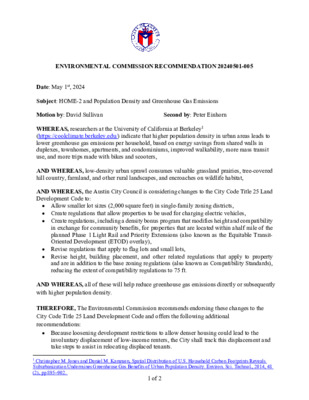Recommendation 20240501-005: HOME-2 and Population Density and Greenhouse Gas Emissions — original pdf
Recommendation

ENVIRONMENTAL COMMISSION RECOMMENDATION 20240501-005 Date: May 1st, 2024 Subject: HOME-2 and Population Density and Greenhouse Gas Emissions Motion by: David Sullivan Second by: Peter Einhorn WHEREAS, researchers at the University of California at Berkeley1 (https://coolclimate.berkeley.edu/) indicate that higher population density in urban areas leads to lower greenhouse gas emissions per household, based on energy savings from shared walls in duplexes, townhomes, apartments, and condominiums, improved walkability, more mass transit use, and more trips made with bikes and scooters, AND WHEREAS, low-density urban sprawl consumes valuable grassland prairies, tree-covered hill country, farmland, and other rural landscapes, and encroaches on wildlife habitat, AND WHEREAS, the Austin City Council is considering changes to the City Code Title 25 Land Development Code to: • Allow smaller lot sizes (2,000 square feet) in single-family zoning districts, • Create regulations that allow properties to be used for charging electric vehicles, • Create regulations, including a density bonus program that modifies height and compatibility in exchange for community benefits, for properties that are located within a half mile of the planned Phase 1 Light Rail and Priority Extensions (also known as the Equitable Transit- Oriented Development (ETOD) overlay), • Revise regulations that apply to flag lots and small lots, • Revise height, building placement, and other related regulations that apply to property and are in addition to the base zoning regulations (also known as Compatibility Standards), reducing the extent of compatibility regulations to 75 ft. AND WHEREAS, all of these will help reduce greenhouse gas emissions directly or subsequently with higher population density. THEREFORE, The Environmental Commission recommends endorsing these changes to the City Code Title 25 Land Development Code and offers the following additional recommendations: • Because loosening development restrictions to allow denser housing could lead to the involuntary displacement of low-income renters, the City shall track this displacement and take steps to assist in relocating displaced tenants. 1 Christopher M. Jones and Daniel M. Kammen, Spatial Distribution of U.S. Household Carbon Footprints Reveals Suburbanization Undermines Greenhouse Gas Benefits of Urban Population Density. Environ. Sci. Technol., 2014, 48 (2), pp 895–902. 1 of 2 • If possible, the City shall take steps to incentivize new higher-density housing in high- opportunity neighborhoods near jobs and existing mass transit. • The City shall track changes in transit use, micromobility use, and walkability in new higher-density developments to verify the predicted emission savings on an annual basis and report back to the Environmental Commission and City Council on an annual basis. • Austin public utilities shall make a presentation to the City Council and Environmental Commission as to the effects of increasing the City’s population density on utility infrastructure. For: Perry Bedford, Jennifer Bristol, Peter Einhorn, Mariana Krueger, Colin Nickells, Haris Qureshi, Melinda Schiera, David Sullivan Vote: 8-1 Against: Richard Brimer Abstain: None Absent: Hanna Cofer Attest: Perry Bedford, Environmental Commission Chair 2 of 2